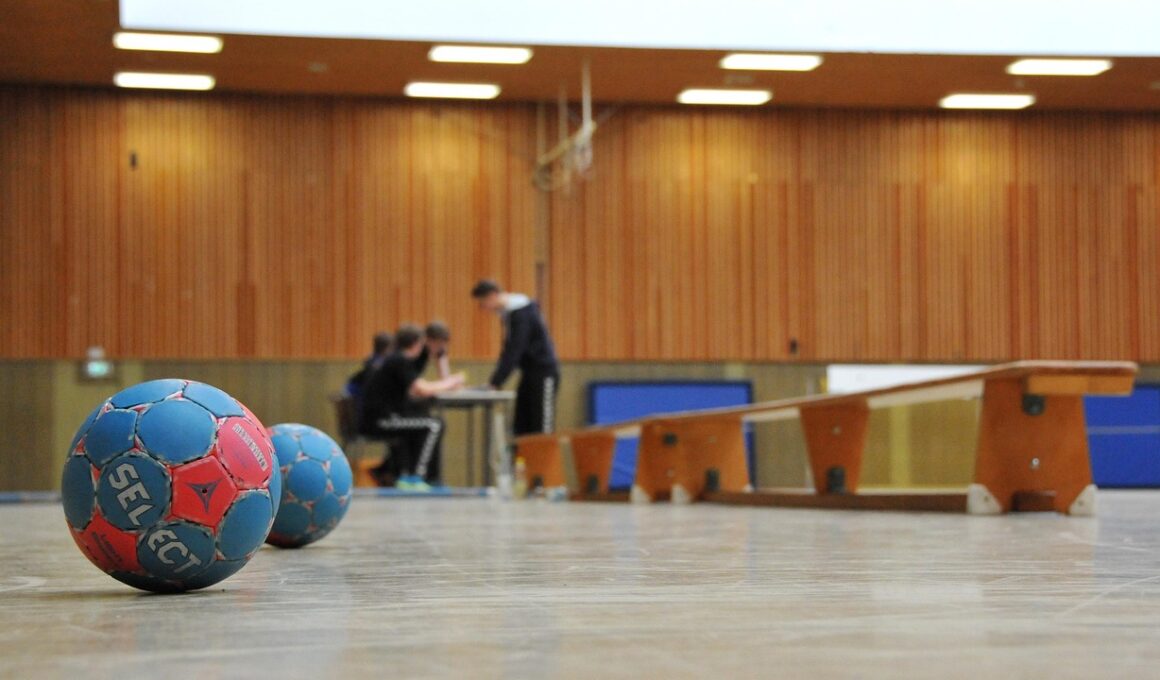Understanding Handball Rules: A Guide for Coaches
Handball is an exciting and fast-paced sport. It requires coaches to understand various rules that govern gameplay. Coaches must be equipped with these rules so they can effectively teach and correct their players when necessary. One of the basic aspects includes how many players are allowed on the court. Each team has seven players, including a goalkeeper. They must also understand substitutions, which occur continuously during the match. Every substitution must be properly executed from the designated area to ensure compliance with handball regulations. Coaches should also be familiar with the method of scoring in handball. Teams score by throwing the ball into the opposing team’s goal, which measures 3 meters high and 2 meters wide. Consequently, coaches should devise strategies focusing on both offensive and defensive techniques. Offenses can involve organized plays while maintaining efficient defensive formations. Rules about fouls and penalties are also critical. Understanding the consequences of various fouls helps coaches maintain fair play and sportsmanship. This knowledge fosters discipline, allowing both players and coaches to flourish in a competitive atmosphere.
The Basic Rules and Regulations
Another essential area of knowledge for coaches is understanding the basic fouls in handball. Common fouls include pushing, holding, and hitting. These infractions can result in free throws for the opposing team. Coaches must educate their players about the severity of these fouls, emphasizing the importance of maintaining control on the court. Additionally, coaches must familiarize themselves with the three-step rule, which allows players to take only three steps while holding the ball without dribbling. After completing the steps, a player must either pass or shoot the ball. Violating this rule results in a turnover. Furthermore, the concept of dribbling is vital, as it allows players to advance the ball down the court. Coaches should encourage their athletes to practice dribbling under pressure. Moreover, understanding the goalkeeper’s specific regulations is crucial. Goalkeepers have unique privileges, such as being able to block players within the goal area. These rules help in creating a well-rounded coaching strategy. Coaches must continuously reinforce these basic rules to ensure their players execute them properly during competitive matches while enhancing their overall game knowledge.
Communication on the field is essential for successful play. Therefore, coaches should emphasize the need for effective verbal and non-verbal communication. Promoting teamwork and trust among players can significantly influence the game’s flow. Coaches should implement strategies during practice sessions to foster this communication. Developing a common understanding of plays and strategies is critical for success in matches. Additionally, understanding the dynamics of the game, including the referee’s role, is vital. Referees enforce the rules and make decisions regarding fouls and violations. Coaches should never argue with referees, as this can lead to penalties for their teams. Instead, coaches should model respect towards referees and educate players about maintaining composure when decisions are made. This respect instills discipline and sportsmanship in players. An essential part of coaching also involves understanding the game clock. Coaches must teach their players to keep track of the remaining time during matches, which influences gameplay decisions. Having a strategic plan for the final minutes is crucial. Ultimately, instilling these communication skills and respect for officials creates a conducive environment for players to thrive.
Training and Skill Development
A significant aspect of handball coaching revolves around skill development. Coaches should plan various drills that focus on fundamental skills such as passing, shooting, and defense. Regular practice of these skills improves player confidence and proficiency. Starting with simple drills and progressively increasing complexity can effectively foster skill growth. For example, passing drills can incorporate movement, ensuring players can pass while in motion. Additionally, shooting drills from various angles enhance a player’s scoring ability under pressure. Defense is equally important; teaching players strategic positioning can disrupt opponents’ plays. Incorporating small-sided games during practice encourages competition and sharpens decision-making skills. Moreover, coaches should focus on physical conditioning, as handball is a high-intensity sport that demands endurance and agility. Implementing fitness routines that target core strength, stamina, and speed can significantly benefit players on the court. Coaches can also introduce video analysis to provide players with visual feedback. Reviewing game footage can highlight both strengths and areas needing improvement. This analysis allows for focused coaching and helps players adapt their individual playing styles to enhance team dynamics.
The mental aspect of handball cannot be overlooked. Coaches must nurture their players in developing a strong mental game. This includes teaching them problem-solving techniques and how to remain calm under pressure. Maintaining composure during critical moments of a match is essential for achieving success. Coaches can conduct visualization exercises to enhance players’ focus and confidence. Imagining scenarios they might face during games prepares them mentally to execute strategies effectively. Furthermore, encouraging goal setting can foster motivation. Players should set individual and team goals, tracking progress regularly during the season. Recognizing achievements, regardless of size, boosts overall morale. Another significant factor in player development involves understanding the concept of resilience. Coaches should instill the importance of bouncing back from setbacks and learning from mistakes. This resilience builds character and improves performance over time. Team-building activities outside of practice can further enhance camaraderie. Engagement in activities fosters a strong team bond, making communication more effective during matches. Coaches should strive to create an atmosphere of trust and support, which is conducive to a positive team environment.
Game Preparation and Strategy
Preparing for a game is multifaceted, requiring coaches to devise comprehensive strategies. Analyzing the strengths and weaknesses of the opposing team plays a vital role in this preparation. Coaches can scout previous games or use video analysis to gather valuable information. Predicting the opponent’s tactics enables coaches to prepare tailored strategies that counter their opponents effectively. For instance, studying an opponent’s top scorer can guide defensive plays. Simulation drills that replicate the opposing team’s style can also enhance readiness. Conducting pre-game meetings to communicate strategies and roles clearly is essential. Players should leave the meeting with confidence in their understanding of game plans. Additionally, encouraging players to focus on their responsibilities ensures that team cohesion remains intact. Coaches should also prepare for halftime adjustments. Analyzing the first half’s performance allows coaches to make necessary changes that could impact the game’s outcome. Reinforcing positivity during game breaks can rejuvenate player morale. Coaches must maintain a balance between motivation and constructive feedback. Understanding when to encourage and when to critique is vital to fostering a winning mentality.
Post-game analysis is an integral part of continuous improvement. After each match, coaches should lead a debriefing session discussing the game’s ups and downs. Encouraging players to share their insights fosters self-reflection and growth. Identifying key moments that influenced the game helps players learn and improve. Constructive feedback is essential during these discussions; highlighting what went well and what needs adjustment promotes a learning environment. Coaches should approach feedback positively, encouraging players to focus on progression rather than mistakes. Furthermore, encouraging players to watch recorded footage from games strengthens their understanding of strategies in action. This analysis allows players to visualize their performances and identify individual areas for improvement. Moreover, reinforcing teamwork and player responsibility during discussions solidifies unity among teammates. Coaches should also recognize and celebrate successes, regardless of the match outcome. Supporting players after difficult games builds resilience and loyalty, fostering a strong team culture. Lastly, setting tangible objectives for the next practice allows players to stay focused. This focused approach encourages commitment to continuous improvement, ensuring the coach’s and team’s growth moving forward.
In conclusion, understanding handball rules is crucial for effective coaching. By grasping the regulations, coaches can provide structured learning experiences for their players. They ensure athletes develop essential skills in a regulated environment. Coaches are responsible for promoting discipline and sportsmanship, emphasizing the importance of following rules. Building a rapport among players enhances communication and team dynamics, which is pivotal for success. A comprehensive coaching strategy that incorporates game preparation, skill development, and mental resilience forms the foundation of an effective handball program. Coaches should continually adapt their approaches based on learning outcomes. Evaluation sessions are valuable for measuring progress and making informed decisions regarding future practices or games. Utilizing this guide, coaches can inspire their players and cultivate a love for handball. The long-term success of athletes often hinges on their understanding of game rules, dynamics, and strategy. Encouraging a thorough grasp allows players to thrive competitively. As coaches support their athletes on this journey, they contribute to the development of effective handball players, ultimately benefiting the sport as a whole.


